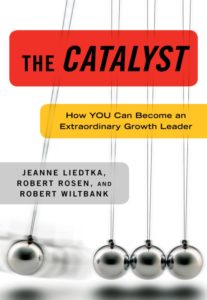So, one of the tool kits that has turned out to be important is kind of a collaborative research and idea generation method, because it is really critical that you align a team around what you are trying to accomplish so that they can channel that diversity they bring into working together to create higher-order, better solutions then any one of the team members came in with in the first place. That’s not easy. Often that diversity will trip us up and actually result in worse ideas than if we are able to really marshal it and make it an asset that helps propel us to better ideas.
Colin: You talked a little earlier about the importance of mindset and of having that collaborative mindset to allow those diverse experiences to be harnessed. One of phrases that I remember from the book and I have reused, is this notion that “the monkey is not on your shoulders, it is in your head;” you know the mindset that barriers to growth are to some extent artificial, as you said self-generated, perhaps from a fear of failure or worrying about making mistakes, and only being comfortable asking questions where you already know the answer. I know this is a tough one, but we’ve talked a little bit about developing repertoire — how do you go about developing a growth mindset?
Jeanne: That is really a challenging question and it’s not just how we develop a growth mindset ourselves, but those of us who are leaders, how do we encourage a growth mindset amongst the people we lead. Most organizations operate on the unspoken principle of avoiding mistakes, right? And so, people don’t try if they can’t be sure that they won’t make a mistake, that is people start making choices based on avoiding error rather than proactively seeking something new and, until you break out of that approach, until you figure out a way to make it safe to be wrong, this is very hard work to do. And that’s really, I think, where a lot of my recent work has been in the area of design thinking, and looking at the design thinking process and methodology.
Take companies like IDEO and Continuum and the major consulting firms, what they have is a systematic approach to doing all of this and a method for conducting these small experiments. So, these techniques that they use actually reduce the risk and investment that you make in any one idea. And because of that they literally make it safer to be wrong. The world that we are living in now, and I often talk about the reality of venture capitalists, you know when you have Silicon Valley and you talk to the best venture capitalists, they will tell you that if they’re very, very lucky, maybe one or two of the new companies that they invest in actually turn out to be successful companies long term. Now how many managers and organizations do you know that can get away with a 10/20 percent success rate?
Not only that, but we come in expecting to succeed 100 percent of the time, hoping to succeed 100 percent of the time because we know that is what everyone else expects. You just can’t do innovation that way. You have to acknowledge that people that do this kind of thing for a living max out at about 20 percent success rate – you’re not going to do a whole lot better than that. Which means you better develop a set of skills and tools that help you to experiment very cheaply and to learn very quickly. Because the issue is not which two to invest in, out of those 10, if he or she knew that then they wouldn’t be investing in the other eight, it’s knowing which eight to stop investing in. We know that about the only thing that is harder for managers to do than to start a new idea is to kill a new idea once it’s going, because killing an idea is an admission of failure. So, if we want to use these methods we have got to be just at good at shutting down an idea that isn’t passing our experiments as we are about starting up a new one. And that is a mindset shift that is very hard for most individuals and most organizations to handle.
Colin: I think you make a great point and I can identify a lot with my own mindset development, where probably as a young and enthusiastic product development engineer, I used to see showing new products and new product concepts to customers as an opportunity to test a hypothesis and to have them reinforce that we were on the right path. The older I have got the more I see it as a learning opportunity to get customer input and to really shape the ideas that we have and to shape the directions that we have, which may include killing it because it simply doesn’t get the level of customer traction that perhaps we had thought at the start. As you say, it’s about experiments, it’s about learning, it’s about not betting the bank and really learning as you go rather than pursuing one mega idea that you hitch your sense of worth and career to and then, when it falls over, the whole thing is relatively disastrous.
Jeanne: Absolutely, you know at some level a lot of this is just logic, it’s amazing how we’ve twisted our logic in large organizations so that what seems completely obvious in retrospect is such a startling revelation, but if we know that the number one reason for new business failure is that they fail to create value for customers.
So, we talk about what are the ingredients in a really good idea? What are the tests that any new business idea has to pass to succeed? They are pretty straightforward. Number one is that they have to create enough value for somebody relative to what someone has got already that they will pay you money for it. And then you have to be able to execute it, you have to be able to defend it against competitors and scale it, and all those other things, but none of the other tests matter if the new idea fails the value test. So, what is this single easiest way to make sure that any new idea doesn’t fail the value test? Well it’s to co-create it with your customers. It’s to pull the customers into the conversation and at least the right kind of customer who wants to be a partner – which is not all customers. But the sooner we pull customers into our creation conversations, the more likely it is that we will avoid the number one source of new product failure.


